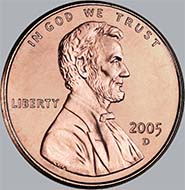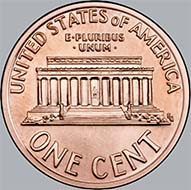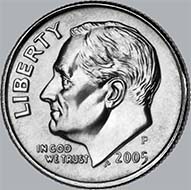A little lesson on American history is taught by the three smallest American coins. The first settlers beginning a new life on North American terrain being zealots, who didn’t saw any future for themselves in the Old World anymore, becomes evident by the images on the coins. IN GOD WE TRUST – this motto can be read on all notes and coins of the United States. Which god is of secondary importance, the main thing is that he is compatible with the American version of freedom. Likewise the word LIBERTY stands on the coins’ obverse in capital letters. The state’s name and another motto can be found on the reverse. E PLURIBUS UNUM – out of many, one – this statement seems more like a claim, not like a fact.
The cent. Source: Wikipedia.
Cent
Who is depicted on the coins ought to be recognized by any patriotic American at once, even though there is no identifying inscription. Surely most people know Abraham Lincoln (President 1861-1865) on the 1 cent piece. Born in 1809 in Kentucky, the 16th President of the USA is considered not only an exemplary “selfmade man“, but America’s conscience. He was the politician who abolished slavery. That this was not only a moral victory but a means Lincoln applied to discipline the more federalist oriented states of the South is swept under the table. The new design of our 1 cent piece was presented in 1959, on the occasion of the 150th anniversary of Mr. President. The reverse shows the Lincoln Memorial, a monument in the style of a Greek temple that was inaugurated in 1922. 36 columns support the building. They represent the 36 states which were members of the United States at the time Lincoln died. The inauguration ceremony, on the other hand, wouldn’t have pleased the honoree. The audience was separated according to race; the black speakers were forced to break down cordon ropes to get to the lectern at all. Despite that, Lincoln Memorial had become a place closely linked to race equality. Consequently, Martin Luther King made his famous speech “I have a dream” in front of this building.
1 cent special editions from 2009. Source: Wikipedia.
On the occasion of the 200th anniversary of Lincoln, a re-design of the cent was planned. Because the US citizens like to hoard special coins, not only one portrait had been chosen, but four. In 2009, new coins were issued every three months devoted to the following topics: 1.) Lincoln’s birth in Kentucky (1809-1816), his years in Indiana (1816-1830), his working life in Illinois (1830-1861) and his presidency in Washington (1861-1865).
The nickel. Quelle: Wikipedia.
Nickel
The 5 cent piece – called nickel in the vernacular – shows the 3rd President of the United States, Thomas Jefferson (President 1801-1809), who is not so well known in this part of the world. Already prior to states got independent from England he was a devoted politician who claimed the “rights of America” in letters and articles. The United States owe to Thomas Jefferson the Declaration of Independence and the two-parties-system: Jefferson founded a party based on a strong participation of the people, which continues in present-day Democrats. Not to forget, the Louisiana Purchase – Jefferson managed to acquire not only the modern state of the same name from Napoleon for roughly 15 million dollars, but a territory corresponding to a quarter of today’s USA.
Although the building shown on the reverse of the 5 cent piece, issued in 1938 for the first time, strongly resembles the Jefferson Memorial in Washington, the inscription MONTICELLO tells us that this isn’t the monument but Jefferson’s villa in Charlottsville, Virginia, Jefferson retreated after his two terms.
By the way, Monticello still being depicted in the most recent nickels harks back to a bill Eric Cantor, Congress Member of Virginia, where Monticello is situated, carried through. The nickel was planned to be entirely re-designesd. Instead of a boring building the US Mint intended to show a portrait of the painter Gilbert Stuart, an Indian and an American eagle. The ones responsible, however, had missed to obtain the Congress’ consent. Cantor’s protest resulted in a law on the continuity of the American 5 cent coin (American 5-cent Coin Design Continuity Act, Public Law 108-15). There it is stipulated that Monticello will be depicted on the coin until Congress decides otherwise. For 2004 and 2005 another motif was agreed upon, since 2006 again the villa is shown, the long-known portrait of the obverse had given way to an en-face portrait of Jefferson.
The dime. Source: Wikipedia.
Dime
Dime – that is what the 10 cent piece of the United States is called. The word derives from the Latin decimus, which the French abbreviated to disme for tithe, and the American adopted as dime. From 1946 onwards, the 1st anniversary of the death of Franklin D. Roosevelt (President 1933-1945) his head can be seen on the dime. Roosevelt originated in the political upper class of the country. He was related to no less than ten presidents including, of course, his cousin Theodore Roosevelt our stuffed bear Teddy got his name from. Franklin D. Roosevelt was elected Governor of New York in 1928 – that was bad timing politically for his term coincided with the “Great Depression”, huge joblessness which hit the state of New York particularly hard. By addressing the citizens via the radio, Roosevelt became famous throughout the country. In the so-called “fireside chats” he informed about his political efforts and tried to comfort the persons concerned. Back then, that was something novel and resulted in Roosevelt becoming widely known. The democrats nominated him in 1932 as candidate for the presidential election, and Roosevelt actually won. He was to win another three election and hence to be the only president residing in the White House for more than two terms of office. With his “New Deal” policy Franklin D. Roosevelt gradually led the United States out the crisis and into World War II. Roosevelt didn’t live to witness the victory of the Allied Forces. He died on April 12, 1945. He was spared to be forced to command the A-bomb to be airdropped.
The reverse of the dimes shows no monument but a torch as symbol for liberty between a laurel branch, symbol for victory, and an oak branch, symbol for the Roosevelt’s popularity.












